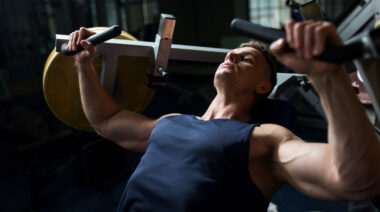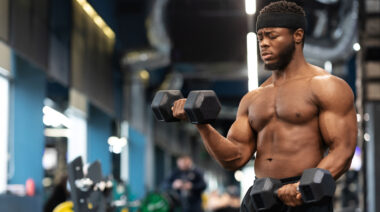I know for some of you this is going to rehash a topic that keeps going round and round throughout the fitness and strength community. Everyone thinks he or she is correct and scoffs at the other side. The good news is this article is not for you. I’m talking to those who have never considered the neck – seriously considered the neck – when it comes to any hinge movements of the hip.
Packing the neck is simply defined as tucking the chin slightly and keeping the head motionless during a lifting attempt. This is one of the most overlooked and underutilised training cues to ensure bigger numbers and more importantly, safer training. Head and neck position in all weight training movements is something you must address. It’s as important as matching your breathing when you lift.Here’s what most people look like when performing a kettlebell swing – a good example of what not to do:
Here’s what most people look like doing the kettlebell swing – a good example of what not to do.
The Neck and the Athlete
The first exercise I teach to any new athlete who walks into my room is the kettlebell swing. I am a big believer in this exercise when it comes to training athletes for millions of reasons. When teaching it, the first major concept we try to impart on the brand new athlete is the idea of spinal or midline stability. If you can’t stabilise your spine, you are a threat to your own well-being by adding load of any kind to your body.
“If you can’t stabilise your spine, you are a threat to your own well-being by adding load of any kind to your body.”
The problem is all athletes and the majority of the coaches out there forget the cervical spine is still a part of the spine. Packing the scaps and tightening the abs will be stressed to protect the back, yet the head and neck are given little attention.
Experience Justifies the Need
I have personally endured a half-dozen seriously show-stopping back blowouts over the past sixteen years. Gnarly, stuck on the floor for two weeks, peeing in a soda bottle, pass me another painkiller type incidents. Those of you who have thrown your back out understand what I am talking about, and those of you who haven’t should thank your lucky stars. Not only are the rehabs painful and recovery time arduously long, but they also set you up for repeat episodes once you’re feeling good again. It has to be on your mind in every task you perform.
“So, for you, the reader of this article, the neutral spine (especially cervical spine) helps keep you safe. Safety is paramount for continued gains.”
I had become very efficient at being mechanically inefficient. With each subsequent injury, my nervous system had reorganised movement patterns to protect me, but created such problematic movement patterns that I was a danger to myself. I wanted to get serious about my training but I knew I was no longer the 21-year-old bulletproof guy I once was (a very tough pill to swallow).
I decided to use my trusty kettlebell and start from the ground up. Problem was, that hinging movement was the exact motion that caused my back to become unhappy. Even with the best technique I was capable of, I could still feel that old nemesis knocking on the door with every swing.
A Massive Breakthrough
My ah-ha moment came when I changed my neck position at the bottom of the swing, completely on accident, no cuing involved. I simply made a subtle adjustment to my head position at the bottom. Instead of allowing my cervical spine to extend so I could keep my eyes up (or more importantly my face up) to counter the bending-over motion, I allowed my head and eyes to ride my shoulders over and, viola, no discomfort in my back. I was so comfortable in this position that mechanically I felt an improvement in my structure and was able to generate more force. The beginning of a lovely relationship.
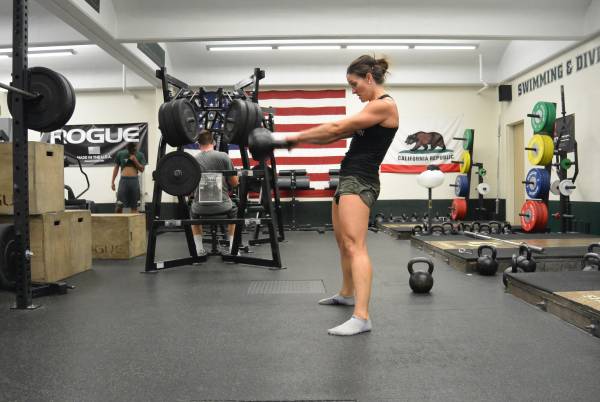
This head down position puts unnecessary tension from the neck through the spine.
Over the course of the next few months I was able to increase my training volume and more importantly, increase my loads. I became so comfortable with this that my staff and I began tinkering with this in every exercise with my athletes. Guess what we saw? The athletes were able to get into position with greater ease. Because of this, we were able to train more efficiently, which leads to bigger gains. What really drove home that I was on the right track was we stopped having low back issues. Completely.
Anatomy of the Spine
We have 33 bones of the spine. The cervical, the thoracic, the lumbar, and the sacral. They are a series of complex structures that carry out many responsibilities. Within these 33 are alternating zones of stability emphasis and mobility emphasis. For example, the thoracic spine is a dynamic zone that should have an adequate amount of available mobility to carry out dynamic twisting motions like swinging a golf club or baseball bat. Concurrently, the cervical spine and lumber spine are meant for more stability based tasks. The stacking of these areas ensures the system can generate large dynamic forces – but more importantly, large dynamic safe forces.

The cervical spine is meant for stability-based tasks.
If one of those tasks is assigned to a zone that is not doing its part – for example, a thoracic spine that is bound up with poor movement where it should have copious amounts of available range of motion – the distribution of force throughout the entire spinal system changes, putting greater load into one of the neighboring areas. If that load is large enough and the spine is hitting maximal tolerances, something will likely give.
“Understand who you are.Don’t kid yourself.A training injury is absolute death to progress, no matter who you are.”
During dynamic, large motion activities like the kettlebell swing, the opportunity for movement in the spine goes up dramatically. A swing has you hinging ballistically, and because of the repeated motion of hinge to lock out, the temptation to fix your visual line on an isolated position demands that the head and neck must move. This is what we are trying to avoid.
How We Teach the Kettlebell Swing
Note: First, get rid of the mirrors in your facilities. In my opinion, it’s one of the biggest problems facing most lifters. We want to see ourselves train. But if you are watching yourself, your attention is drawn to what you see and you completely forfeit what you’re supposed to be feeling. Pure, true, balls-to-the-walls athleticism starts with body awareness.
When executing the swing, we need to understand that spinal stability is of utmost importance. An unstable system is a weak and dangerous system. In our effort to maximise the ability to produce force, we must achieve levels of stability throughout the system. We start with the spine in the swing.
Find two fixed points in the room: one on the floor about four feet in front of you and one on the wall in front of you a couple feet above your horizontal visual line. Typically, we mark with chalk or use some kind of spot on the floor for bottom position and where the roof and walls meet as the top position. This ensures our athletes have targets to locate with their eyes when they get into the various postures.
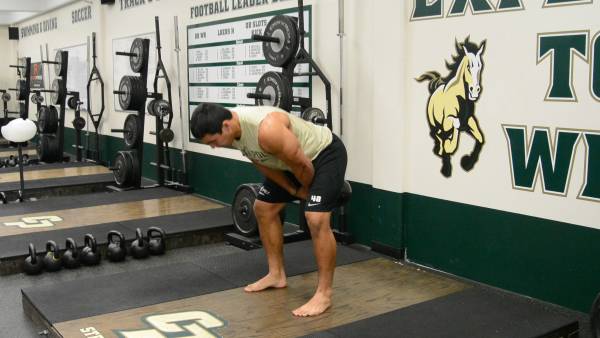
“Look with your face” and not only with your eyes.
We’ve found that you need to layer in an additional cue when it comes to locating your targets. We tell our athletes, “Look with your face, not only with your eyes.” We’ve found that in an attempt to satisfy us, the athletes will first only look with their eyes and their heads continue to rock back and forth.
In the top position, the crown of the head should get tall – again, looking with both your eyes and your face. In an attempt to make us coaches happy, we’ve found that the hardest part of this type of cuing for the athletes is looking down when they hinge – thus, when they get to the top, they continue to look down. So get your crown tall at the top, along with getting your face and eyes down at the bottom.
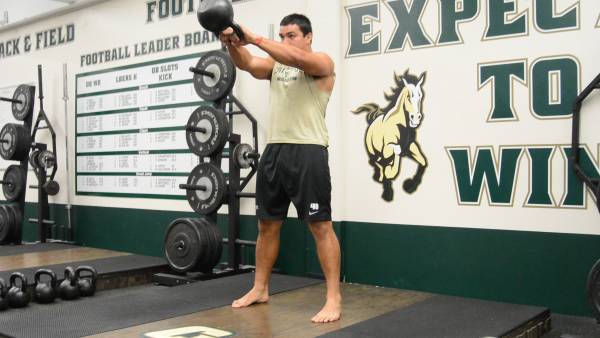
In the top position, the crown of the head should get tall – again, looking with both your eyes and your face.
Understand this will feel a little weird the first time you attempt it. If you are used to looking up at the bottom of a swing, this will feel downright wrong in the beginning. Quickly, though, this will become comfortable and what most will experience is another gear they can access when they master this.
Slight head movement is okay. Slight. I have only coached a handful of people who can keep their heads entirely motionless when they swing.
Alternative Viewpoints
I get that there are reasons people are on opposing camps on this issue. The arguments are solid ones. Unfortunately, most of the reasons to do this or not to do this in your training can be explained either way. My powerlifting friends might be on the other side of the fence saying we need the head back because it helps fire the erectors of the spine. I’m sure you could find high-end Olympic lifters who would say this might not be optimal for whatever reason, too. And I’m okay with that.
“At what point, in terms of absolute strength, do we have enough?Enough to complete the task in dominant fashion.”
What the vast majority of us need to understand is – we are not those people. I would guess that 99% of you reading this are not competing for a world title at the moment. With my football players, we use powerlifting ideas, we use Olympic weightlifting exercises, and we practice with kettlebell routines, but we still remain football players. We are using these methods to make us faster and stronger in hope of making us better football players.
So, at what point, in terms of absolute strength, do we have enough? Enough to complete the task in dominant fashion. Can a starting center have enough strength with a 220kg squat, 180kg bench, and a 150kg clean? In my eyes, this person is strong enough to do his job effectively.
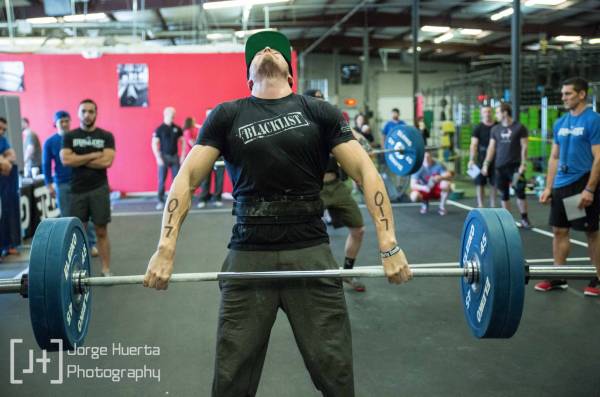
We are not Olympic weightlifters. We just want to be stronger and faster.
If this is all advice you have never heard before, I strongly urge you to give it a try in your next training session. It can be applied to any lift, not just the swing. We have found tremendous success with this one cue over the past five or six years. That equates to nearly 3,000-4,000 Division I athletes we have applied this to with overwhelming success.
Understand who you are. Don’t kid yourself. A training injury is absolute death to progress, no matter who you are. So, for you, the reader of this article, the neutral spine (especially cervical spine) helps keep you safe. Safety is paramount for continued gains.
Related Content:
- The 5 Deadliest Kettlebell Swings
- The What-the-Hell Effect and How the Swing Improves Everything
- All You Need to Know About Getting Started With Kettlebells
- New on Pulse Beat Fit UK Today
Photos 1, 2, 4 & 5 courtesy of Chris Holder.
Photo 3 courtesy of Shutterstock.
Photo 6 courtesy of Jorge Huerta Photography.

